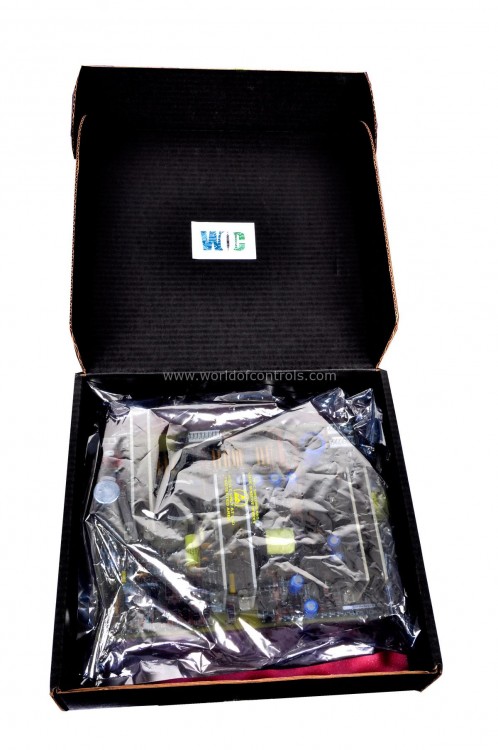
World Of Controls understands the criticality of your requirement and works towards reducing the lead time as much as possible.
DS200SPAF1ABH 01 - EX2100 Excitation Control Module is available in stock which ships the same day.
DS200SPAF1ABH 01 - EX2100 Excitation Control Module comes in UNUSED as well as REBUILT condition.
To avail our best deals for DS200SPAF1ABH 01 - EX2100 Excitation Control Module, contact us and we will get back to you within 24 hours.
SPECIFICATIONS:
Part Number: DS200SPAF1ABH 01
Manufacturer: General Electric
Series: EX2100
Input Voltage: 95�140 VAC
Output Current: Up to 600 A
Operating Temperature: 0 �C to +60 �C
Weight: 1.7 lbs
Availability: In Stock
Country/Region of Manufacture: United States
Repair: 3-7 Days
Manual: GEH-6632
FUNCTIONAL DESCRIPTION:
DS200SPAF1ABH 01 is an EX2100 Excitation Control Module manufactured and designed by General Electric as part of the EX2100 Series used in Excited Turbine Control Systems. The EX2100 Excitation Control (EX2100 or exciter) produces the field excitation current to control the generator ac terminal voltage and/or the reactive volt-amperes. It is a full static excitation system designed for generators on both new and retrofit steam, gas, and hydro turbines. The exciter is a flexible modular system that can be assembled to provide a range of available output currents and several levels of system redundancy. These options include power from a potential, compound, or auxiliary source. Single or multiple bridges, warm backup bridges, and simplex or redundant controls are available.
Power for the exciter is drawn from a power potential transformer connected to the generator terminals, or from an excitation transformer connected to an auxiliary bus. Generator line current and stator output voltage are the primary feedbacks to the exciter, and dc voltage and current are the controlled outputs to the exciter field. The architecture supports Ethernet LAN (Unit Data Highway) communication with other GE equipment, including the GE Control System Toolbox (toolbox) for configuration, the turbine control, the LCI Static Starter, and the HMI (operator interface).
INSTALLATION:
Excitation control results from phase controlling the output of the SCR bridge circuit. The SCR firing signals are generated by digital regulators in the controller. In the redundant control option (Figure 1-2), either M1 or M2 can be the active master control, while C monitors both to determine which should be the active and which the standby controller. Dual independent firing circuits and automatic tracking is used to ensure a smooth transfer to the standby controller.
HARDWARE: The EX2100 hardware is a control cabinet, which contains the control, communication, and I/O boards; an auxiliary cabinet, which includes field flashing and protection circuits such as de-excitation and shaft voltage suppression; and a power conversion cabinet, which houses the power SCR cells, cooling fans, DC contactors, and AC disconnect. The exciter�s power converter comprises bridge rectifiers, resistor/capacitor filter configurations, and control circuitry, with component specifications and bridge size varying according to the excitation system type and the required power output.
SOFTWARE: Microprocessor-based controllers (ACLA and DSPX) execute the exciter control code. The software consists of modules (blocks) combined to create the required system functionality. Block definitions and configuration parameters are stored in flash memory, while variables are stored in random-access memory (RAM). The exciter application software emulates traditional analog controls. It uses an open architecture system, with a library of existing software blocks configured from the toolbox. The blocks individually perform specific functions, such as logic gates, proportional integral (P.I.) regulators, function generators, and signal level detectors.
POWER CONVERSION CABINET:
The Power Conversion cabinet contains the Power Conversion Module (PCM), the Exciter Gate Pulse Amplifier (EGPA) board, ac circuit breaker, and the dc circuit contactor. Three-phase power for the PCM comes from a PPT external to the exciter. The AC supply comes into the cabinet through the ac circuit breaker (if supplied), and is filtered by 3-phase line filters in the auxiliary cabinet. The manual AC disconnect switch serves as a disconnect device between the secondary of the power potential transformer and the static exciter. It is a molded case, 3-phase, non-automatic, panel-mounted switch, which is manually operated for isolating the ac input supply. It is a no-load disconnect device.
WOC maintains the largest inventory of GE EX2100 Excitation Control System replacement parts, providing fast and reliable access to new, unused, or factory-rebuilt components, all backed by a comprehensive warranty. In addition to supplying parts, we offer expert repair services for faulty boards and provide 24/7 support from our team of skilled engineers and technicians for troubleshooting, installation, and technical guidance. With a focus on minimizing downtime and ensuring optimal system performance, WOC delivers trusted solutions and rapid assistance, helping your operations run smoothly and efficiently.
What is an Excitation Control Module?
An Excitation Control Module regulates the exciter field current of a generator, ensuring stable voltage output and efficient reactive power control. It is essential for maintaining reliable turbine operation under varying load conditions.
What are the main components of the module?
The module includes a control cabinet (control, communication, and I/O boards), an auxiliary cabinet (protection circuits, de-excitation, and shaft voltage suppression), and a power conversion cabinet (SCR bridge rectifiers, DC contactors, AC disconnects, RC filters, and cooling fans).
How does the module regulate generator voltage?
Voltage is controlled through phase-controlled SCR bridge outputs, with digital regulators generating firing signals. In redundant configurations, active and standby controllers automatically switch to ensure smooth excitation control.